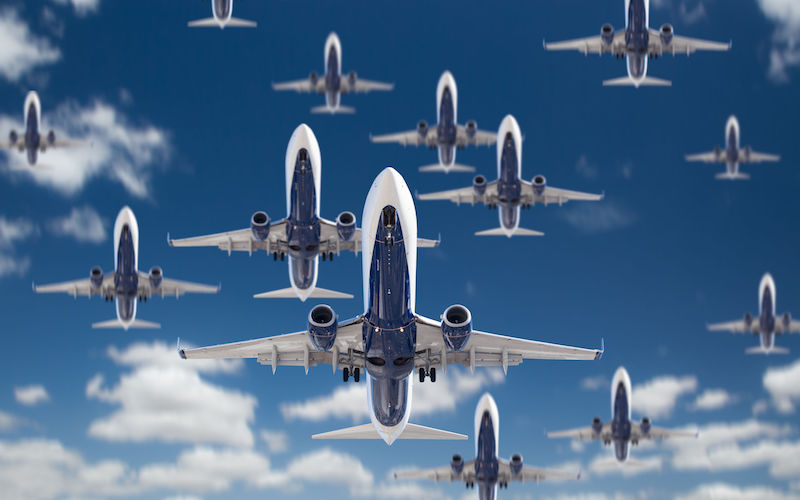If Heathrow has its way, be prepared for low flying aircraft! Proposed changes to air traffic management (ATM) and a changed protocol to spread aircraft over more London boroughs could see Merton and neighbours suffering added inbound westerly air traffic for the very first time. Wimbledon could see aircraft as low as 2000 feet, and, ‘worst case’, inbound aircraft overhead at the rate of one every minute and a half. Residents in Wimbledon, Richmond, Cobham, Esher, Weybridge, Kingston and other towns should access “Heathrow’s Airspace Design Envelopes for Expansion, January 2019” website for potential new traffic movements over their homes.
Heathrow’s proposed third runway will add 255,000 flights per annum, or 700 per day! Changes to ATM will add 25,000 more. Together they would increase current traffic by 60% to around 765,000 flights per annum. No surprise, then, that these two separate but related proposals will generate more noise, more pollution and add more carbon to both the planet and our neighbourhoods. Although technology will produce quieter, cleaner aircraft in the future, it is thought that viable electric aircraft are at least fifty years away.
With Heathrow already badly sited in the heart of London suburbs, the prospect of adding another airport the size of Gatwick to its operations defies logic. Particulate & NO2 pollution, already exceeding EU limits can only worsen with increased ground and air traffic. Almost one million people are already afflicted by aircraft noise and an expansion could see this number doubled. On the climate front, departing aircraft currently generate c20 million tons of CO2 and this will increase before, perhaps, returning to roughly the same level by 2060. It is completely at odds with the government’s committed policy of ‘zero carbon’ by 2050.
If this is not enough to stop the expansion, the demolition of 800 houses, the bulldozing of two villages, the commandeering of 1000+ acres of greenbelt and farmland, the rerouting of rivers, the tunnelling of the M25 and the general environmental damage surely should be. Add to this the fact that expansion construction will impact local communities for over thirty years and the transport network capability for increased passenger loading has not been fully assessed or costed. As important, the figures used to promote this scheme appear to be based on flawed assumptions and conclusions. At best they only generate an average Net Present Value of ZERO. It is also not clear whether Heathrow itself knows what this project will cost. Is it £14bn, £30bn, £50bn or £100bn? Whatever, it seems logical to conclude that the government and taxpayer will be contributing billions to a project promoted largely by foreign shareholders.
Heathrow secured government support largely due to its supposed economic contribution to the UK economy given its present questionable ‘hub’ advantage. However, given that over 70% of its traffic is for tourism, spurred on by ‘cheap flights’, it seems clear that it would be better for England and the planet to reduce air travel rather than increase it. In so doing, there would be no need for a third runway at Heathrow and no need for another one at Gatwick or at any other airport. Brexit, the Trump tariff wars, general global economic uncertainties and communication technologies will anyway reduce the need for air travel, aircraft and runways …not only in the UK, but globally.
Readers can help stop the Heathrow Expansion by writing or emailing their views to their councils, MP’s, to the CAA and to Heathrow. They can support opposing bodies like No3rdRunway, Stop Heathrow Expansion, HACAN and many others. Check their websites for details. Sitting back and doing nothing is not an option. The third runway must be consigned to history and the proposed airspace routing changes must be reconsidered.
Project status: following government approval in June 2018 (now the subject of a Judicial Review Appeal), Heathrow’s second and final Airport Expansion consultation was commissioned in June this year. Heathrow is now preparing its DCO application for submission to the Department of Transport in 2020 for a decision in 2021. Approval would see a third runway added by 2026.
Heathrow: Expanded Operations
If Heathrow has its way, be prepared for low flying aircraft! Proposed changes to air traffic management and a changed protocol to spread aircraft over more London boroughs could see many homes in the south suffering added inbound westerly traffic for the first time! Wimbledon could experience aircraft as low as 2000 feet! Residents in Wimbledon, Richmond, Cobham, Esher, Weybridge and other towns should access the “Heathrow’s Airspace Design Envelopes for Expansion” website.
With Heathrow already badly sited close to the city, the prospect of adding another airport the size of Gatwick defies logic. Pollution, already exceeding EU limits can only worsen with increased ground and air traffic. Almost one million people are already afflicted by aircraft noise and an expansion could see this number doubled. Departing aircraft currently generate 20 million tons of CO2 and this will increase; completely at odds with the government’s committed policy of ‘zero carbon’ by 2050.
The horrendous impact of construction work on neighbouring communities and the environment [1000 demolished houses, two villages bulldozed, 1000 acres of greenbelt/farmland lost, and more] is totally unacceptable. The transport network capability for increased passenger numbers has also not been fully assessed and the figures used to promote this scheme appear based on flawed assumptions and conclusions; generating an overall average Net Present Value of ZERO. It is also not clear whether Heathrow knows what the expansion will cost. Is it £14bn, £50bn or £100bn? And, at what cost to the government and taxpayer?
Heathrow is preferred for its so-called ‘hub’ advantages, but given that 72% of its traffic is tourist related, spurred on by ‘cheap flights, it would be better for the planet to reduce air travel rather than increase it. There would then be no near-term need for another runway at Heathrow, Gatwick or at any other airport.
Government-approved in June 2018 [subject to a Judicial Review], Heathrow’s final Airport Expansion consultation was commissioned in June this year. Its application will be submitted to the Department of Transport in 2020 for a decision in 2021. Approval would see a third runway added by 2026.
The Heathrow Expansion project can be stopped. Readers can write to their councils, MP’s, the Civil Aviation Authority and Heathrow and join opposing bodies such as No3rdRunwayCoalition et al.




